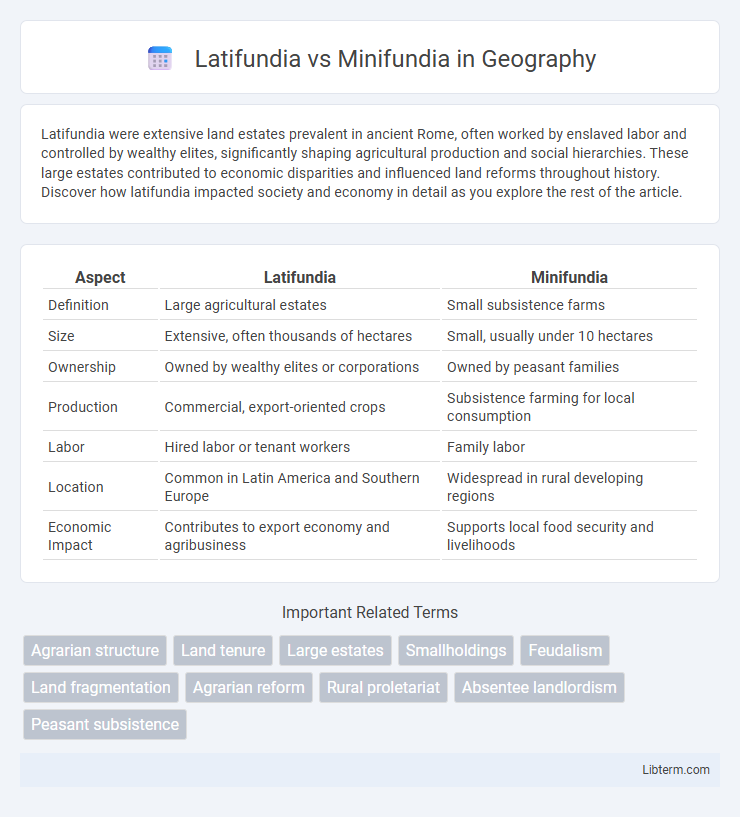Latifundia were extensive land estates prevalent in ancient Rome, often worked by enslaved labor and controlled by wealthy elites, significantly shaping agricultural production and social hierarchies. These large estates contributed to economic disparities and influenced land reforms throughout history. Discover how latifundia impacted society and economy in detail as you explore the rest of the article.
Table of Comparison
| Aspect | Latifundia | Minifundia |
|---|---|---|
| Definition | Large agricultural estates | Small subsistence farms |
| Size | Extensive, often thousands of hectares | Small, usually under 10 hectares |
| Ownership | Owned by wealthy elites or corporations | Owned by peasant families |
| Production | Commercial, export-oriented crops | Subsistence farming for local consumption |
| Labor | Hired labor or tenant workers | Family labor |
| Location | Common in Latin America and Southern Europe | Widespread in rural developing regions |
| Economic Impact | Contributes to export economy and agribusiness | Supports local food security and livelihoods |
Understanding Latifundia and Minifundia
Latifundia are large agricultural estates typically exceeding several hundred hectares, often associated with extensive monoculture and mechanized farming, primarily found in Latin America. Minifundia are small-scale farms, usually less than five hectares, characterized by subsistence farming with diverse crop cultivation and manual labor. Understanding the economic and social impacts of latifundia and minifundia reveals disparities in land distribution, productivity, and rural livelihoods across developing regions.
Historical Origins of Latifundia and Minifundia
Latifundia originated in ancient Rome as large agricultural estates owned by wealthy elites, often worked by enslaved people, and played a significant role in shaping the Roman economy and social structure. Minifundia developed later, primarily during the medieval period, characterized by small family-owned plots that provided subsistence farming for peasant households. The contrast between latifundia and minifundia highlights the shift from expansive, labor-intensive plantations to smaller, more manageable agricultural units in different historical contexts.
Geographic Distribution of Landholdings
Latifundia are large estates typically found in Latin America, especially in countries like Brazil, Argentina, and Mexico, characterized by vast landholdings used primarily for extensive agriculture or cattle ranching. Minifundia, conversely, consist of small plots predominantly located in mountainous or rural regions of Central and South America, where land is intensively cultivated by families for subsistence farming. The geographic distribution reflects economic disparities, with latifundia concentrated in fertile, lowland areas, while minifundia occupy less arable, fragmented terrains.
Economic Impacts of Large vs. Small Farms
Large latifundia farms generate significant economic output through mechanization and scale economies, driving export revenues and capital accumulation in agribusiness sectors. In contrast, small minifundia farms often support subsistence livelihoods but face challenges in productivity and market access, limiting their contribution to broader economic growth. The disparity between these farm sizes highlights the need for policy interventions that balance efficiency with rural employment and food security.
Social Structures and Class Dynamics
Latifundia, large estates controlled by wealthy landowners, often reinforce rigid social hierarchies by concentrating land ownership and wealth in the hands of an elite class, resulting in significant power imbalances and limited social mobility. Minifundia, small family-run farms, promote more egalitarian social structures within rural communities by enabling subsistence farming and fostering close-knit, cooperative relations among peasants and smallholders. The contrast between these landholding systems highlights the role of land distribution in shaping class dynamics, where latifundia perpetuate elite dominance while minifundia support peasant resilience and local autonomy.
Agricultural Productivity and Efficiency
Latifundia, characterized by large-scale estates, often benefit from advanced mechanization and resource investment, leading to higher agricultural productivity per hectare compared to minifundia. In contrast, minifundia, which are small-scale family farms, typically face limitations in capital and technology, resulting in lower efficiency but potentially higher labor intensity and crop diversity. The disparity in productivity between latifundia and minifundia significantly impacts rural economies and food production systems, with latifundia driving commercial agriculture while minifundia sustain subsistence farming.
Land Reform Movements and Policies
Latifundia and minifundia represent contrasting landholding patterns, with latifundia being large estates often controlled by elites, while minifundia consist of small family farms. Land reform movements aimed to redistribute latifundia holdings to address social inequality and improve rural livelihoods by promoting equitable land access. Key policies in countries like Mexico and Brazil focused on expropriating underutilized latifundia and supporting minifundia expansion to enhance agricultural productivity and reduce poverty.
Environmental Consequences of Land Fragmentation
Latifundia, large estates often characterized by monoculture, contribute significantly to soil degradation and loss of biodiversity due to extensive deforestation and intensive chemical use. Conversely, minifundia, small fragmented plots owned by subsistence farmers, often promote agroforestry and polyculture practices that support soil conservation and maintain ecological balance. Land fragmentation associated with minifundia can lead to increased landscape heterogeneity, which benefits local ecosystems but may also complicate large-scale land management and environmental planning.
Case Studies: Latin America and Beyond
Latifundia, large estates primarily found in countries like Brazil and Argentina, demonstrate concentrated land ownership with extensive use of mechanized agriculture, often linked to significant social inequality and environmental degradation. Minifundia, prevalent in regions such as Mexico and Guatemala, consist of small subsistence farms that support rural livelihoods but face challenges like low productivity and limited access to markets. Case studies reveal that while latifundia drive export-oriented agriculture, minifundia remain central to food security and local economies, highlighting the complex land tenure dynamics shaping Latin America's agrarian landscape and extending to similar patterns in parts of Africa and Asia.
Future Trends in Landholding Patterns
Future trends in landholding patterns indicate a gradual shift from expansive latifundia dominated by large agribusinesses toward more diversified and sustainable minifundia managed by smallholder farmers. Technological advancements, such as precision agriculture and blockchain for land registry, enable efficient management and traceability, promoting equitable land use. Increasing governmental policies and international pressure aim to redistribute land to enhance food security and rural livelihoods, potentially reducing land concentration and empowering local communities.
Latifundia Infographic

 libterm.com
libterm.com